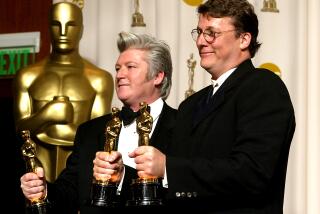In honor of haunting visuals
- Share via
Conrad L. Hall, one of the giants of Hollywood filmmaking whose death from cancer in January at age 76 was mourned throughout the world of cinema, posthumously won the Academy Award on Sunday evening for best cinematography for his dark and gritty images in the underworld drama “Road to Perdition.”
Hall’s celluloid visuals, so haunting and perfectively conceived at times that they have been compared to paintings, received his third Oscar in a trend-setting career spanning more than four decades.
A 10-time Academy Award nominee, he had previously won statuettes for 1999’s Oscar-winning picture “American Beauty” and 1969’s romantic western “Butch Cassidy and the Sundance Kid.”
Accepting the award was his son, Conrad W. Hall, a cinematographer himself, who tipped the Oscar statuette to the sky in tribute to his father.
“A couple of months ago, the industry lost one of its best legends,” Conrad W. Hall said. “Many of you lost a great friend and colleague. I lost my father. It’s been said God gives each and every one of us life and what we do with our life is what we give back to him. My gift was my father. Dad, wherever you are, you are gone, but you are not forgotten.”
Sam Mendes, who collaborated with Hall on “Road to Perdition” and won the Oscar for best director after working beside the cinematographer on “American Beauty,” said Hall was not merely a craftsman but also an artist.
Hall was known to be self-effacing but extremely demanding of himself.
“He was inspired because he never accepted second best and he was his own worst critic,” Mendes recalled. “He was very, very tough on himself.”
Hall was not the first person to posthumously receive an Oscar. Peter Finch died two months before capturing the Academy Award for his role as a mad television news anchor who promises to commit suicide on camera in 1976’s “Network.” Others who won posthumously include lyricist Howard Ashman, who died of AIDS in 1991, the year for which he and composer Alan Menken received two trophies in the music category for Disney’s animated feature “Beauty and the Beast,” and composer Victor Young, who won in a musical category for 1956’s “Around the World in 80 Days.”
Grover Crisp, who oversees film restoration at Sony Pictures Entertainment, worked closely with Hall over the last five years restoring three of the cinematographer’s classic works -- “In Cold Blood,” “Fat City” and “The Professionals.” Crisp said what amazed him about Hall’s “Road to Perdition” was that “you can take almost any frame from almost any shot and you can frame it and hang it on the wall. It’s like a painting.”
“One thing Connie used to say to me was, ‘Don’t be afraid to not see something in detail,’ ” Crisp said. “What he meant was, don’t be afraid to make [a film] look dark. There is this idea that if you can’t see detail in a scene, there is something wrong. In video, they are all the time cranking it up so they see all the detail.”
Laszlo Kovacs, the cinematographer on such classic films as “Easy Rider” and “Five Easy Pieces,” said that one of Hall’s signature scenes occurred in 1967’s “In Cold Blood,” when Robert Blake is near a window reflecting back on his father and rain hitting the window pane makes it appear that tears are coursing down Blake’s face.
“[Hall] made the actor cry,” Kovacs marveled. “[Blake] almost didn’t need to act because of the visuals. The tears are running down his eyes and it gives you so much about the character.” Kovacs said.
Vilmos Zsigmond, the man operating the lens in such pictures as “McCabe & Mrs. Miller” and “Deliverance,” said: “I see a Conrad Hall movie and there’s no camera there. There’s light there, but there’s no mistakes. He knew what he was doing. He was the best.”
John Bailey, the cinematographer of films like “As Good as It Gets” and “Groundhog Day,” said that if one examines Hall’s body of work, including “In Cold Blood,” “Fat City,” “The Day of the Locust,” “Butch Cassidy and the Sundance Kid,” “Tequila Sunrise” and “Road to Perdition,” he was always attracted to characters who were antiheroes.
“But through his work and the way he used his camera,” Bailey noted, “he brought a human dimension to them that was very much a reflection of how he himself dealt with people in the world around him.”
More to Read
Only good movies
Get the Indie Focus newsletter, Mark Olsen's weekly guide to the world of cinema.
You may occasionally receive promotional content from the Los Angeles Times.










